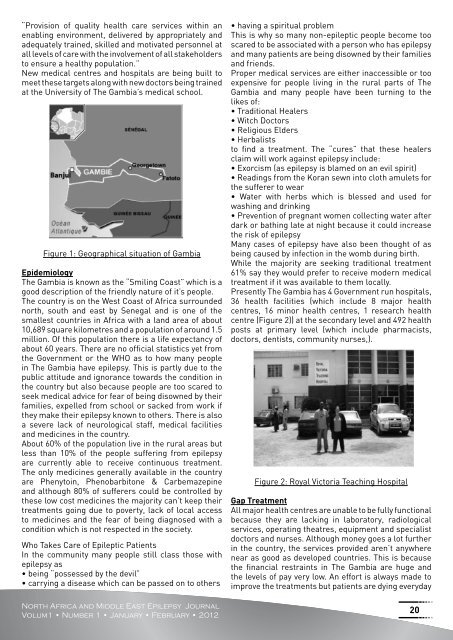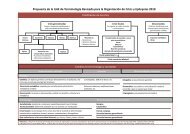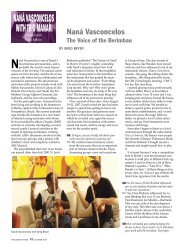Neurologist, Morocco - Amazon Web Services
Neurologist, Morocco - Amazon Web Services
Neurologist, Morocco - Amazon Web Services
You also want an ePaper? Increase the reach of your titles
YUMPU automatically turns print PDFs into web optimized ePapers that Google loves.
“Provision of quality health care services within an<br />
enabling environment, delivered by appropriately and<br />
adequately trained, skilled and motivated personnel at<br />
all levels of care with the involvement of all stakeholders<br />
to ensure a healthy population.”<br />
New medical centres and hospitals are being built to<br />
meet these targets along with new doctors being trained<br />
at the University of The Gambia’s medical school.<br />
Figure 1: Geographical situation of Gambia<br />
Epidemiology<br />
The Gambia is known as the “Smiling Coast” which is a<br />
good description of the friendly nature of it’s people.<br />
The country is on the West Coast of Africa surrounded<br />
north, south and east by Senegal and is one of the<br />
smallest countries in Africa with a land area of about<br />
10,689 square kilometres and a population of around 1.5<br />
million. Of this population there is a life expectancy of<br />
about 60 years. There are no official statistics yet from<br />
the Government or the WHO as to how many people<br />
in The Gambia have epilepsy. This is partly due to the<br />
public attitude and ignorance towards the condition in<br />
the country but also because people are too scared to<br />
seek medical advice for fear of being disowned by their<br />
families, expelled from school or sacked from work if<br />
they make their epilepsy known to others. There is also<br />
a severe lack of neurological staff, medical facilities<br />
and medicines in the country.<br />
About 60% of the population live in the rural areas but<br />
less than 10% of the people suffering from epilepsy<br />
are currently able to receive continuous treatment.<br />
The only medicines generally available in the country<br />
are Phenytoin, Phenobarbitone & Carbemazepine<br />
and although 80% of sufferers could be controlled by<br />
these low cost medicines the majority can’t keep their<br />
treatments going due to poverty, lack of local access<br />
to medicines and the fear of being diagnosed with a<br />
condition which is not respected in the society.<br />
Who Takes Care of Epileptic Patients<br />
In the community many people still class those with<br />
epilepsy as<br />
• being “possessed by the devil”<br />
• carrying a disease which can be passed on to others<br />
North Africa and Middle East Epilepsy Journal<br />
Volum1 • Number 1 • January • February • 2012<br />
• having a spiritual problem<br />
This is why so many non-epileptic people become too<br />
scared to be associated with a person who has epilepsy<br />
and many patients are being disowned by their families<br />
and friends.<br />
Proper medical services are either inaccessible or too<br />
expensive for people living in the rural parts of The<br />
Gambia and many people have been turning to the<br />
likes of:<br />
• Traditional Healers<br />
• Witch Doctors<br />
• Religious Elders<br />
• Herbalists<br />
to find a treatment. The “cures” that these healers<br />
claim will work against epilepsy include:<br />
• Exorcism (as epilepsy is blamed on an evil spirit)<br />
• Readings from the Koran sewn into cloth amulets for<br />
the sufferer to wear<br />
• Water with herbs which is blessed and used for<br />
washing and drinking<br />
• Prevention of pregnant women collecting water after<br />
dark or bathing late at night because it could increase<br />
the risk of epilepsy<br />
Many cases of epilepsy have also been thought of as<br />
being caused by infection in the womb during birth.<br />
While the majority are seeking traditional treatment<br />
61% say they would prefer to receive modern medical<br />
treatment if it was available to them locally.<br />
Presently The Gambia has 4 Government run hospitals,<br />
36 health facilities (which include 8 major health<br />
centres, 16 minor health centres, 1 research health<br />
centre (Figure 2)) at the secondary level and 492 health<br />
posts at primary level (which include pharmacists,<br />
doctors, dentists, community nurses,).<br />
Figure 2: Royal Victoria Teaching Hospital<br />
Gap Treatment<br />
All major health centres are unable to be fully functional<br />
because they are lacking in laboratory, radiological<br />
services, operating theatres, equipment and specialist<br />
doctors and nurses. Although money goes a lot further<br />
in the country, the services provided aren’t anywhere<br />
near as good as developed countries. This is because<br />
the financial restraints in The Gambia are huge and<br />
the levels of pay very low. An effort is always made to<br />
improve the treatments but patients are dying everyday<br />
20
















